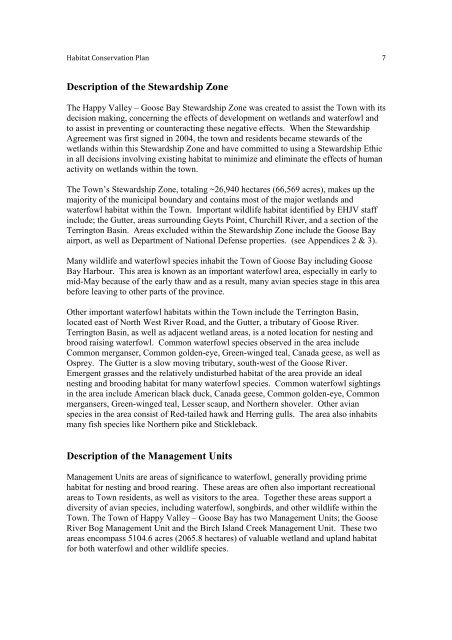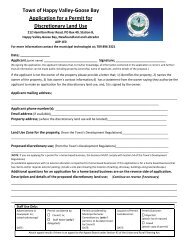Habitat Conservation Plan Habitat Conservation Plan for the Town ...
Habitat Conservation Plan Habitat Conservation Plan for the Town ...
Habitat Conservation Plan Habitat Conservation Plan for the Town ...
- No tags were found...
Create successful ePaper yourself
Turn your PDF publications into a flip-book with our unique Google optimized e-Paper software.
<strong>Habitat</strong> <strong>Conservation</strong> <strong>Plan</strong> 7Description of <strong>the</strong> Stewardship ZoneThe Happy Valley – Goose Bay Stewardship Zone was created to assist <strong>the</strong> <strong>Town</strong> with itsdecision making, concerning <strong>the</strong> effects of development on wetlands and waterfowl andto assist in preventing or counteracting <strong>the</strong>se negative effects. When <strong>the</strong> StewardshipAgreement was first signed in 2004, <strong>the</strong> town and residents became stewards of <strong>the</strong>wetlands within this Stewardship Zone and have committed to using a Stewardship Ethicin all decisions involving existing habitat to minimize and eliminate <strong>the</strong> effects of humanactivity on wetlands within <strong>the</strong> town.The <strong>Town</strong>’s Stewardship Zone, totaling ~26,940 hectares (66,569 acres), makes up <strong>the</strong>majority of <strong>the</strong> municipal boundary and contains most of <strong>the</strong> major wetlands andwaterfowl habitat within <strong>the</strong> <strong>Town</strong>. Important wildlife habitat identified by EHJV staffinclude; <strong>the</strong> Gutter, areas surrounding Geyts Point, Churchill River, and a section of <strong>the</strong>Terrington Basin. Areas excluded within <strong>the</strong> Stewardship Zone include <strong>the</strong> Goose Bayairport, as well as Department of National Defense properties. (see Appendices 2 & 3).Many wildlife and waterfowl species inhabit <strong>the</strong> <strong>Town</strong> of Goose Bay including GooseBay Harbour. This area is known as an important waterfowl area, especially in early tomid-May because of <strong>the</strong> early thaw and as a result, many avian species stage in this areabe<strong>for</strong>e leaving to o<strong>the</strong>r parts of <strong>the</strong> province.O<strong>the</strong>r important waterfowl habitats within <strong>the</strong> <strong>Town</strong> include <strong>the</strong> Terrington Basin,located east of North West River Road, and <strong>the</strong> Gutter, a tributary of Goose River.Terrington Basin, as well as adjacent wetland areas, is a noted location <strong>for</strong> nesting andbrood raising waterfowl. Common waterfowl species observed in <strong>the</strong> area includeCommon merganser, Common golden-eye, Green-winged teal, Canada geese, as well asOsprey. The Gutter is a slow moving tributary, south-west of <strong>the</strong> Goose River.Emergent grasses and <strong>the</strong> relatively undisturbed habitat of <strong>the</strong> area provide an idealnesting and brooding habitat <strong>for</strong> many waterfowl species. Common waterfowl sightingsin <strong>the</strong> area include American black duck, Canada geese, Common golden-eye, Commonmergansers, Green-winged teal, Lesser scaup, and Nor<strong>the</strong>rn shoveler. O<strong>the</strong>r avianspecies in <strong>the</strong> area consist of Red-tailed hawk and Herring gulls. The area also inhabitsmany fish species like Nor<strong>the</strong>rn pike and Stickleback.Description of <strong>the</strong> Management UnitsManagement Units are areas of significance to waterfowl, generally providing primehabitat <strong>for</strong> nesting and brood rearing. These areas are often also important recreationalareas to <strong>Town</strong> residents, as well as visitors to <strong>the</strong> area. Toge<strong>the</strong>r <strong>the</strong>se areas support adiversity of avian species, including waterfowl, songbirds, and o<strong>the</strong>r wildlife within <strong>the</strong><strong>Town</strong>. The <strong>Town</strong> of Happy Valley – Goose Bay has two Management Units; <strong>the</strong> GooseRiver Bog Management Unit and <strong>the</strong> Birch Island Creek Management Unit. These twoareas encompass 5104.6 acres (2065.8 hectares) of valuable wetland and upland habitat<strong>for</strong> both waterfowl and o<strong>the</strong>r wildlife species.






